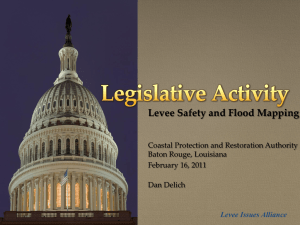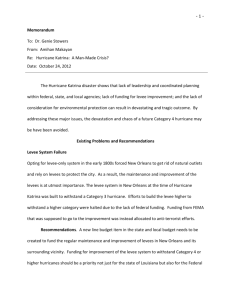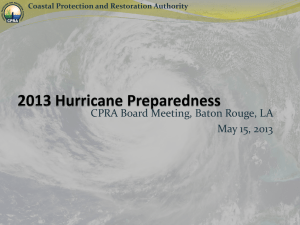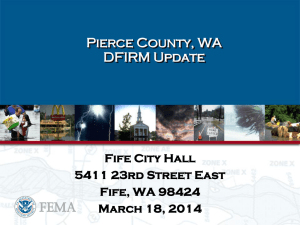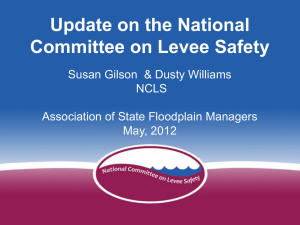Rd 799 Regulations For Builders And Developers
advertisement
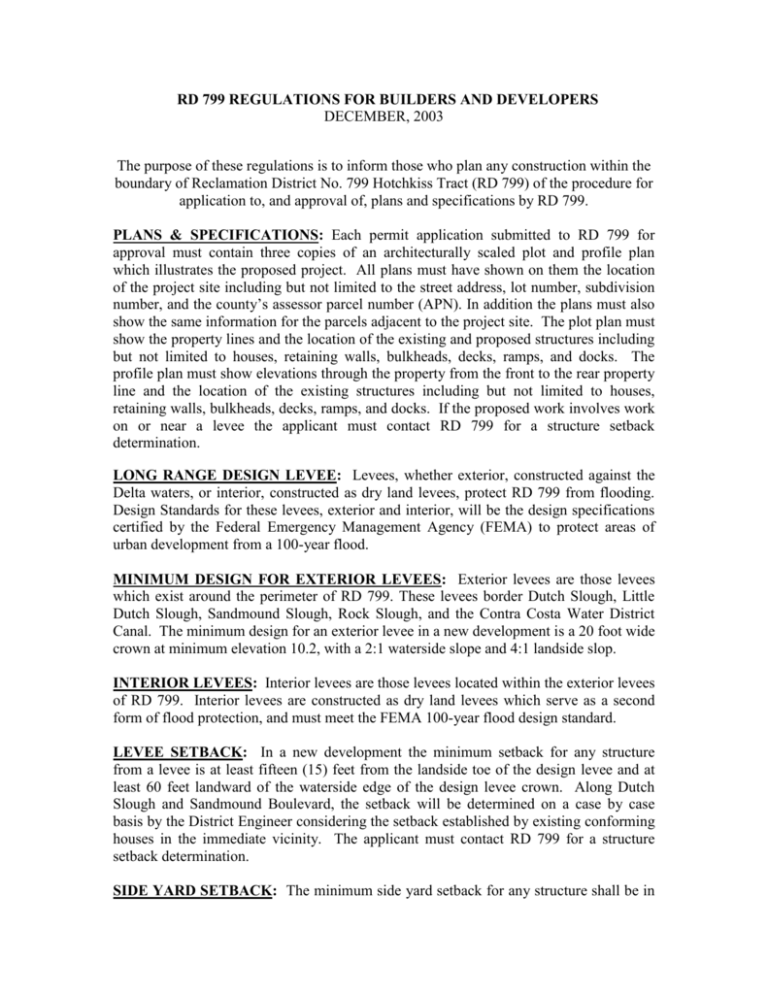
RD 799 REGULATIONS FOR BUILDERS AND DEVELOPERS DECEMBER, 2003 The purpose of these regulations is to inform those who plan any construction within the boundary of Reclamation District No. 799 Hotchkiss Tract (RD 799) of the procedure for application to, and approval of, plans and specifications by RD 799. PLANS & SPECIFICATIONS: Each permit application submitted to RD 799 for approval must contain three copies of an architecturally scaled plot and profile plan which illustrates the proposed project. All plans must have shown on them the location of the project site including but not limited to the street address, lot number, subdivision number, and the county’s assessor parcel number (APN). In addition the plans must also show the same information for the parcels adjacent to the project site. The plot plan must show the property lines and the location of the existing and proposed structures including but not limited to houses, retaining walls, bulkheads, decks, ramps, and docks. The profile plan must show elevations through the property from the front to the rear property line and the location of the existing structures including but not limited to houses, retaining walls, bulkheads, decks, ramps, and docks. If the proposed work involves work on or near a levee the applicant must contact RD 799 for a structure setback determination. LONG RANGE DESIGN LEVEE: Levees, whether exterior, constructed against the Delta waters, or interior, constructed as dry land levees, protect RD 799 from flooding. Design Standards for these levees, exterior and interior, will be the design specifications certified by the Federal Emergency Management Agency (FEMA) to protect areas of urban development from a 100-year flood. MINIMUM DESIGN FOR EXTERIOR LEVEES: Exterior levees are those levees which exist around the perimeter of RD 799. These levees border Dutch Slough, Little Dutch Slough, Sandmound Slough, Rock Slough, and the Contra Costa Water District Canal. The minimum design for an exterior levee in a new development is a 20 foot wide crown at minimum elevation 10.2, with a 2:1 waterside slope and 4:1 landside slop. INTERIOR LEVEES: Interior levees are those levees located within the exterior levees of RD 799. Interior levees are constructed as dry land levees which serve as a second form of flood protection, and must meet the FEMA 100-year flood design standard. LEVEE SETBACK: In a new development the minimum setback for any structure from a levee is at least fifteen (15) feet from the landside toe of the design levee and at least 60 feet landward of the waterside edge of the design levee crown. Along Dutch Slough and Sandmound Boulevard, the setback will be determined on a case by case basis by the District Engineer considering the setback established by existing conforming houses in the immediate vicinity. The applicant must contact RD 799 for a structure setback determination. SIDE YARD SETBACK: The minimum side yard setback for any structure shall be in accordance with the County of Contra Costa’s uniform building code for the appropriate zoning. FRONT YARD SETBACK: The minimum front yard setback for any structure shall be in accordance with the County of Contra Costa’s uniform building code for the appropriate zoning. PATROL ROADS: RD 799 will require all new subdivisions constructed adjacent to or along the District’s levee to provide RD 799 with access patrol roads along the levee crown and across the entire frontage of the subdivision. In addition the subdivider must provide access to the levee from the nearest public road to the access patrol road on the crown of the levee. The purpose of the access patrol road on the crown of the levee is so that emergency vehicles (levee maintenance, fire and ambulance) will have access to the levee-top. The access patrol roads will be a minimum of 20 feet wide, with a turning radius at the levee-top of at least 20 feet, without any encumbrances to inhibit a vehicle turning. DECK & DOCK RAMPS: Ramps used to access either a house, deck or dock from the levee crown may not exceed four feet in width and must be constructed in a manner to not block the access patrol road on the crown of the levee. VEHICLE RAMPS: Ramps used to access the patrol road on the crown of the levee will be considered for approval. The design of these vehicle ramps will be carefully evaluated and the District may require a soils report prepared by a Registered Civil or Geotechnical Engineer addressing the impacts of such a ramp on the structural integrity of the District’s levee. Such report shall include adequate test borings or excavations, plus levee stability and seepage analysis. Additional design considerations will include provisions for a turning radius sufficient to accommodate a large rock carrying truck or large emergency vehicle. RD 799 requires that a minimum of one ramp be constructed per 20 lot subdivision, or one ramp per 35 lots in subdivisions of over 20 lots. DECKS: Decks, whether attached or unattached to a house on the landside of a levee, may not encroach more than ten (10) feet into the “structure setback” for a levee, provided that the deck is supported on posts or piling. Decks may not be roofed, have wing walls, or be enclosed below or above the deck surface. The support beams of a deck must have at least 12 inches clearance above ground. The house and house roof must be structurally independent from the deck, so that if a deck is removed, the house will remain structurally sound. Decks will not be permitted to be constructed over the waterside slope of a levee. RETAINING WALLS OR BULKHEADS: Retaining walls or bulkheads will generally be permitted on the lower half of the landside or waterside slopes of a levee if they do not encroach into the design levee and are three feet or less in height. LANDSCAPE TERRACING: Terracing for the purpose of landscaping on either the landside or waterside slope of a levee will generally be permitted if the retaining walls do not encroach into the design levee and are one foot or less in height. PIPING AND/OR CONDUIT: The invert of all pipes and conduit running through the levee must be 1 foot above the 100-year, base flood elevation of 7.0 feet (USGS Datum), and buried at least 12 inches below the surface of the levee-top roadway. Pipes carrying liquid or gas must have shutoff valves located at a minimum of ten (10) feet landward of the toe of the levee and clearly marked to show their location. IRRIGATION PIPE & SYSTEMS: Irrigation pipes or sprinkler systems installed in the District’s levee are considered an encroachment and may only be placed along the landside edge of the access patrol road on the levee top. Any water applied to vegetation on the levee shall be controlled to prevent erosion of the levee slopes. No ditch shall be dug in a levee section for the purpose of irrigation of vegetation. Sprinkler pipes may not be buried deeper than eight (8) inches into a levee slope. An accessible shut-off valve shall be located a minimum of ten (10) feet landward from the levee toe, and clearly marked to show its location. DOCKS AND/OR BERTHS: Both fixed and/or floating docks or berths will be setback at least ten (10) feet beyond the mean lower low tide line. DREDGING: The design of any dredging project adjacent to a District levee will be carefully evaluated, and the District may require a soils report from a Registered Civil or Geotechnical Engineer addressing the impacts of such dredging on the structural integrity of the District’s levee. All dredging applications must include the approval of the U.S. Army Corps of Engineers and any other concerned Local, State or Federal agencies. FILLING AND/OR DISPOSING OF DREDGE SPOILS: Filling and/or disposing of dredge spoils shall be performed in accordance with the terms and conditions set forth in the Dredging permit discussed above. REMODELING OF STRUCTURES: Remodeling of structures is considered construction and therefore must adhere to all the regulations set forth herein. PERFORMANCE BONDS: Performance bonds may be required as a condition of approval by RD 799 for developers and/or contractors. FENCES: Fences constructed on the District’s levees must be of open construction to allow unrestricted levee inspections on either slope. Wire fences parallel to the levee-top must have an unlocked gate. If security demands a locked gate, Rd 799 must be provided a key to the locked gate. No fences will be allowed that are constructed perpendicular to the access patrol road on the levee-top. Access patrol roads on the levee top must remain open for use by all emergency and/or inspection vehicles. BARRICADES: Barricades constructed on the District’s levees may not restrict traffic along the access patrol roads on the levee top. Access patrol roads on the levee top must remain open for use by all emergency and/or inspection vehicles. PARKING: Parking of vehicles on or along the access patrol road on the levee top is prohibited, unless specifically allowed by a RD 799 permit. However, property owners may park on the waterside of the paved one mile section of access patrol road on top of the levee road along Dutch Slough, west of Bethel Island Bridge provided that there is not adequate room at the landside toe of the levee on their property. NO MANDATORY DUTY: The adoption of these Regulations are not intended to and shall not be construed or given effect in a manner that imposes upon RD 799 or any officer, agent, or employee thereof a mandatory duty of care toward persons and property within or without RD 799 so as to provide a basis of civil liability for damages, except as otherwise imposed by law.
